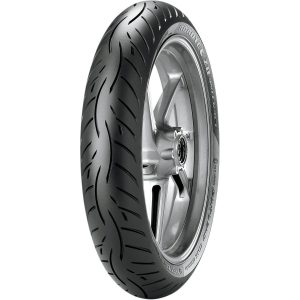Introducing the Metzler Roadtec Z8 Interact Rear Tire
When it comes to exceptional performance on two wheels, the Metzler Roadtec Z8 Interact Rear Tire stands out as a sport radial tire par excellence. Boasting a speed rating of 72 W, it caters to a diverse range of bikes. Whether you’re riding high-speed racing bikes or the mighty adventure touring beasts from renowned brands like Kawasaki, Triumph, or BMW, this tire promises to deliver.
Mileage That Outshines The Competition
One of the primary aspects to underline about the Metzler Roadtec Z8 is its incredible mileage potential. Surpassing many of its competitors in the market, this tire becomes a go-to choice for those prioritizing longevity without compromising on performance. Its adaptability to serve a plethora of purposes makes it a top pick for many biking aficionados.
Built for Heavy-duty Usage
Quality and resilience are at the heart of the Roadtec Z8’s design. The tire incorporates a robust 2-ply carcass, ensuring it’s tailor-made for heavier usage scenarios. This feature becomes particularly advantageous for weighty bikes, guaranteeing extended tire life compared to many of its counterparts.
Choosing the Right Spec for Your Ride
Recognizing the varied needs of riders, Metzler offers different specifications for the Roadtec Z8. For those steering bikes like the Concours, the O spec tire emerges as the ideal choice. Meanwhile, avid riders of the 1000 or 600cc sport bikes, who desire enhanced grip and superior efficiency, will find the M spec tire perfectly aligning with their demands.
The Metzler Roadtec Z8: A New Era in Tire Technology
If mileage isn’t the only aspect you’re eyeing in a tire, the O spec of the Metzler Roadtec Z8 might just be your go-to choice. This variant boasts an array of features tailored to meet diverse riding needs. Designed primarily as a recreational touring tire, it serves equally well for riders seeking optimal performance or a comprehensive activity tire.
Design & Efficiency
The tire‘s design is nothing short of commendable. One look at its tread pattern and you’ll notice an increased number of grooves, strategically placed closer together. Not only does this provide more tread than usual, but it also facilitates superior water evacuation, ensuring the tire performs seamlessly across varied usage conditions.
Innovative Water Channeling
The tire incorporates a pie design reminiscent of the Greek π symbol – a nod to our mathematical days. But beyond its aesthetic appeal, this design plays a crucial role in channeling water away from the tire’s surface. This ensures excellent stability in line, right down the core of the tire. When leaning over, riders can expect enhanced performance due to its rounded profile, guaranteeing smooth handling at every turn.
The Power of Interact Technology
The “Interact” in its name isn’t just for show. This technology involves a steel belt that continuously wraps around the tire. Serving multiple purposes, the steel belt’s tension can be adjusted based on the winding intensity. This unique feature allows riders to fine-tune the tire’s carcass characteristics, giving them control over its flexibility and ensuring a ride tailored to their preferences.
Understanding the Advanced Technology of Modern Tires
In today’s world of advanced vehicular engineering, the importance of tire technology cannot be underestimated. Let’s delve into one of the remarkable features of modern tires: the steel belt integration.
Heat Dissipation and Tire Longevity
One major innovation in tire technology is the integration of a steel belt. The steel serves a pivotal role in drawing away heat from the tire and evenly distributing it throughout the carcass. This mechanism facilitates efficient heat dissipation, ensuring that the tire remains cool even under demanding conditions. Consequently, such a tire not only performs optimally but also boasts an extended lifespan.
Drive Technology and Zone Configuration
Delving deeper into the tire’s anatomy reveals its intricate drive technology. This particular tire employs a three-zone configuration, optimized to handle different terrains and stresses. At its base, where the wear and tear are paramount, the design emphasizes maximum rigidity. Here, the strips are positioned closer together, tightly wound to render a stiffer carcass. This ensures the tire’s resilience against daily road challenges.
Transitioning towards the sides, a noticeable change in the band distribution can be observed. These bands are spaced further apart and are not wound as tightly. This design choice ensures that as the tire leans, it can flex slightly more, allowing riders to experience enhanced grip and performance, particularly when maneuvering through corners.
Conclusion
The evolution of tire technology is a testament to the relentless pursuit of performance, safety, and durability in the automotive industry. By incorporating features like steel belts for heat dissipation and a three-zone configuration for optimized performance, modern tires like the one discussed offer a harmonious blend of efficiency and longevity. Riders can now enjoy a seamless journey, confident in their tire’s ability to adapt and respond to diverse road challenges. It’s clear that such advancements are not just enhancing the driving experience but are also setting new standards for the future of mobility.



